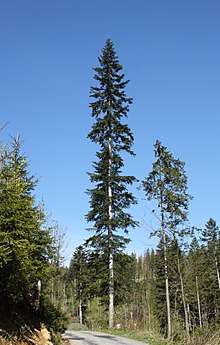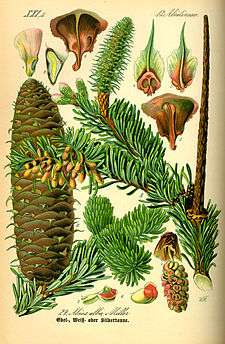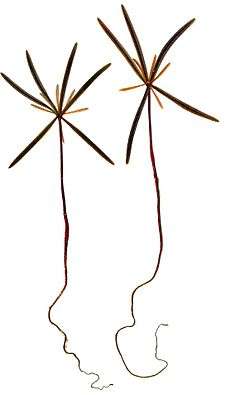Abies alba
| Abies alba | |
|---|---|
 | |
| Abies alba in Silesian Beskids, Poland | |
| Scientific classification | |
| Kingdom: | Plantae |
| Division: | Pinophyta |
| Class: | Pinopsida |
| Order: | Pinales |
| Family: | Pinaceae |
| Genus: | Abies |
| Species: | A. alba |
| Binomial name | |
| Abies alba | |
 | |
| Distribution map | |
| Synonyms[2] | |
|
List
| |
Abies alba, the European silver fir or silver fir,[3] is a fir native to the mountains of Europe, from the Pyrenees north to Normandy, east to the Alps and the Carpathians, Slovenia, Croatia, Bosnia and Herzegovina, Montenegro, Serbia, and south to Italy, Bulgaria, Albania and northern Greece; it is also commonly grown on Christmas tree plantations in the North East region of North America spanning New England in the USA to the Maritime provinces of Canada.[1]
%2C_Italy.jpg)


Description
Abies alba is a large evergreen coniferous tree growing to 40–50 m (130–160 ft) (exceptionally 60 m (200 ft)) tall and with a trunk diameter up to 1.5 m (4 ft 11 in). The largest measured tree was 60 m tall and had a trunk diameter of 3.8 m (12 ft). It occurs at altitudes of 300–1,700 m (980–5,580 ft) (mainly over 500 m (1,600 ft)), on mountains with rainfall over 1,000 millimetres (39 in) per year.[3]
The leaves are needle-like, flattened, 1.8–3.0 cm (0.71–1.18 in) long and 2.0 mm (0.079 in) wide by 0.5 mm (0.020 in) thick, glossy dark green above, and with two greenish-white bands of stomata below. The tip of the leaf is usually slightly notched at the tip. The cones are 9–17 cm (3.5–6.7 in) long and 3–4 cm (1.2–1.6 in) broad, with about 150-200 scales, each scale with an exserted bract and two winged seeds; they disintegrate when mature to release the seeds. The wood is white, leading to the species name alba.[3]
When cultivated on Christmas Tree plantations, the tree naturally forms a symmetrical triangle shape. The trees are full and dense with strong evergreen fragrance, and are known to be one of the longest lasting after being cut. In the forest the evergreen tends to form stands with other firs and beeches.[3] It is closely related to Bulgarian fir (Abies borisiiregis) further to the southeast in the Balkan Peninsula, Spanish fir (Abies pinsapo) of Spain and Morocco and Sicilian fir (Abies nebrodensis) in Sicily, differing from these and other related Euro-Mediterranean firs in the sparser foliage, with the leaves spread either side of the shoot, leaving the shoot readily visible from above. Some botanists treat Bulgarian fir and Sicilian fir as varieties of silver fir, as A. alba var. acutifolia and A. alba var. nebrodensis, respectively.
Ecology
Silver fir is an important component species in the dinaric calcareous block fir forest in the western Balkan Peninsula.
In Italy, the silver fir is an important component of the mixed broadleaved-coniferous forest of the Apennine Mountains, especially in northern Apennine. The fir prefer a cold and humid climate, in northern exposition, with a high rainfall (over 1500 mm per year). In the oriental Alps of Italy, silver firs grow in mixed forests with Norway spruce, beech, and other trees.
Its cone scales are eaten by the caterpillars of the tortrix moth Cydia illutana, while C. duplicana feeds on the bark around injuries or canker.
Chemistry and pharmacology
The bark and wood of silver fir are rich in antioxidative polyphenols.[4][5] Six phenolic acids were identified (gallic, homovanillic, protocatehuic, p-hydroxybenzoic, vanillic and p-coumaric), three flavonoids (catechin, epicatechin and catechin tetramethyl ether) and eight lignans (taxiresinol, 7-(2-methyl-3,4-dihydroxytetrahydropyran-5-yloxy)-taxiresinol, secoisolariciresinol, laricinresinol, hydroxymatairesinol, isolariciresinol, matairesinol and pinoresinol).[6][4] The extract from the trunk was shown to prevent atherosclerosis in guinea pigs[7] and to have cardioprotective effect in isolated rat hearts.[8] Silver fir wood extract was found to reduce the post-prandial glycemic response (concentration of sugar in the blood after the meal) in healthy volunteers.[9]
Uses
A resinous essential oil can be extracted. This pine-scented oil is used in perfumes, bath products, and aerosol inhalants.[3] Its branches (including the leaves, bark and wood) were used for production of spruce beer.[10]
Silver fir is the species first used as a Christmas tree, but has been largely replaced by Nordmann fir (which has denser, more attractive foliage), Norway spruce (which is much cheaper to grow), and other species.
The wood is strong, lightweight, light-colored, fine grained, even-textured and long fibered. The timber is mainly used as construction wood, furniture, plywood, pulpwood and paper manufacture.[11]
Etymology
Abies is derived from Latin, meaning ‘rising one’. The name was used to refer to tall trees or ships.[12]
Alba means ‘bright’ or ‘dead white’.[12]
See also
- Abies amabilis (Pacific silver fir)
References
- 1 2 Farjon, A. (2014). "Abies alba". IUCN Red List of Threatened Species. Version 2014.2. International Union for Conservation of Nature. Retrieved 28 August 2014.
- 1 2 "Abies alba". World Checklist of Selected Plant Families (WCSP). Royal Botanic Gardens, Kew. Retrieved 12 Oct 2016 – via The Plant List.
- 1 2 3 4 5 Gualtiero Simonetti (1990). Stanley Schuler, ed. Simon & Schuster's Guide to Herbs and Spices. Simon & Schuster, Inc. ISBN 0-671-73489-X.
- 1 2 Eva Tavčar Benković , Dušan Žigon, Vladimir Mihailović, Tanja Petelinc, Polona Jamnik & Samo Kreft (2017): Identification, in vitro and in vivo antioxidant activity, and gastrointestinal stability of lignans from silver fir (abies alba) wood extract, Journal of Wood Chemistry and Technology, DOI: 10.1080/02773813.2017.1340958
- ↑ Vasincu A, Creţu E, Geangalău I, Amalinei RL, Miron A. Polyphenolic content and antioxidant activity of an extractive fraction from Abies alba bark.Rev Med Chir Soc Med Nat Iasi. 2013 Apr-Jun;117(2):545-50.
- ↑ Tavčar Benković, Eva; Grohar, Tina; Žigon, Dušan; Švajger, Urban; Janeš, Damjan; Kreft, Samo; Štrukelj, Borut (2014). "Chemical composition of the silver fir (Abies alba) bark extract Abigenol® and its antioxidant activity". Industrial Crops and Products. 52: 23–28. doi:10.1016/j.indcrop.2013.10.005.
- ↑ Drevenšek, Gorazd; Lunder, Mojca; Tavčar Benković, Eva; Mikelj, Ana; Štrukelj, Borut; Kreft, Samo. "Silver fir (Abies alba) trunk extract protects guinea pig arteries from impaired functional responses and morphology due to an atherogenic diet". Phytomedicine. 22: 856–861. doi:10.1016/j.phymed.2015.06.004.
- ↑ Drevenšek G, Lunder M, Benković ET, Štrukelj B, Kreft S. Cardioprotective effects of silver fir (Abies alba) extract in ischemic-reperfused isolated rat hearts. Food Nutr Res. 2016 Oct 17;60:29623. doi: 10.3402/fnr.v60.29623.
- ↑ Debeljak, J.; Ferk, P.; Čokolič, M.; Zavratnik, A.; Tavč Benković, E.; Kreft, S.; Štrukelj, B.: Randomised, double blind, cross-over, placebo and active controlled human pharmacodynamic study on the influence of silver fir wood extract (Belinal) on post-prandial glycemic response. Die Pharmazie - An International Journal of Pharmaceutical Sciences, Volume 71, Number 10, October 2016, pp. 566-569(4)
- ↑ London Medical Gazette, September 23, 1837, page 935: https://books.google.si/books?id=TPQaAQAAMAAJ
- ↑ Wolf, Heino. "Silver fir - Abies alba" (PDF). EUFORGEN Technical guidelines for genetic conservation and use.
- 1 2 Gledhill, David (2008). "The Names of Plants". Cambridge University Press. ISBN 9780521866453 (hardback), ISBN 9780521685535 (paperback). pp 32, 41
- Kunkar, Alp; Kunkar, Ennio. Le piante officinali della Calabria (in Italian). Laruffa Editore. ISBN 88-7221-140-9.
External links
| Wikimedia Commons has media related to Abies alba. |
- conifers.org: Abies alba
- botany.cz: Abies alba Mill
- photomazza.com: Abies alba
- conifersaroundtheworld.com: Abies alba - European White Fir.
- pfaf.org: Abies alba Mill.
- monumentaltrees.com: The thickest, tallest, and oldest European silver fir trees (Abies alba)
- baumkunde.de: Weiß-Tanne (Abies alba) | In German
- Abies alba. Distribution map, genetic conservation units and related resources. European Forest Genetic Resources Programme (EUFORGEN)

